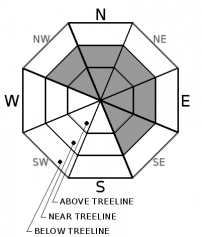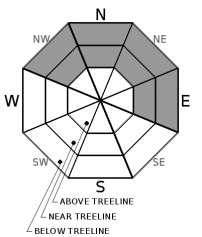| Saturday | Saturday Night | Sunday | |
|---|---|---|---|
| Weather: | Mostly cloudy. Snow levels 7500 feet increasing to 8500 feet in the afternoon. Chance of precipitation is 5%. | Cloudy. Chance of rain and snow in the evening, then snow and rain after midnight. Snow levels 8500 feet decreasing to 7500 feet after midnight. Chance of precipitation is 100%. | Mostly cloudy. Snow in the morning, then chance of snow in the afternoon. Snow levels below 7000 feet. Chance of precipitation is 100%. |
| Temperatures: | 42 to 48. deg. F. | 28 to 33. deg. F. | 33 to 38. deg. F. |
| Mid Slope Winds: | Southwest to west up to 10 mph. | Southwest 10 to 20 mph. Gusts to 35 mph after midnight. | Southwest 15 to 25 mph with gusts to 35 mph. |
| Expected snowfall: | No accumulation. | SWE = none. | 80% probability up to 2 inches. 20% probability of 2 to 5 inches. | SWE = 0.20-0.45 inch. | 80% probability of 2 to 4 inches. 20% probability of 4 to 6 inches. | SWE = 0.15-0.25 inch. |
| Saturday | Saturday Night | Sunday | |
|---|---|---|---|
| Weather: | Mostly cloudy. Snow levels 7500 feet increasing to 8500 feet in the afternoon. Chance of precipitation is 5%. | Cloudy. Chance of rain and snow in the evening, then snow after midnight. Snow levels 8500 feet decreasing to 7500 feet after midnight. Chance of precipitation is 100%. | Mostly cloudy. Snow in the morning, then chance of snow in the afternoon. Snow levels below 7000 feet. Chance of precipitation is 100%. |
| Temperatures: | 38 to 44. deg. F. | 24 to 30. deg. F. | 28 to 34. deg. F. |
| Ridge Top Winds: | Southwest to west 15 to 25 mph with gusts to 35 mph in the morning decreasing to 10 to 20 mph. | Southwest 15 to 25 mph with gusts to 35 mph increasing to 25 to 40 mph with gusts to 65 mph after midnight. | Southwest 30 to 45 mph decreasing to 20 to 30 mph in the afternoon. Gusts up to 65 mph. |
| Expected snowfall: | No accumulation. | SWE = none. | 80% probability of 2 to 4 inches. 20% probability of 4 to 6 inches. | SWE = 0.25-0.50 inch. | 80% probability of 2 to 4 inches. 20% probability of 4 to 6 inches. | SWE = up to 0.30 inch. |


























